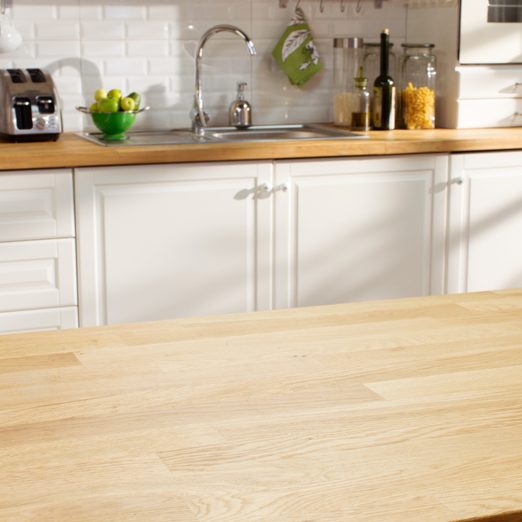How To Install Butcher Block Countertops
Wooden counters add depth and natural flair to your kitchen. Here's how to install butcher block countertops.
Three Days
Intermediate
$300
Introduction
Butcher block countertops are a beautiful, durable and affordable option. Most big box home improvement stores sell them, and they're DIYable with a few basic woodworking tools and skills.
I like them for lots of reasons. They're far more affordable than quartz, granite or soapstone. You can finish them in so many ways. It's relatively easily to round the corners or make artistic curves along the front edge with a jigsaw. And they're easily repairable and look great for years.
We chose a countertop project that's seven feet long and 25 inches deep, which we'll stain and coat with a thick epoxy. Here's how it's done: I like them for lots of reasons. They're far more affordable than quartz, granite or soapstone. You can finish them in so many ways. It's relatively easily to round the corners or make artistic curves along the front edge with a jigsaw. And they're easily repairable and look great for years. We chose a countertop project that's seven feet long and 25 inches deep, which we'll stain and coat with a thick epoxy. Here's how it's done.Tools Required
- 3-in. paintbrush
- Adjustable wood clamps at least six inches long
- Circular saw
- Drill
- Drill and bits
- Four foot level
- Framing square
- Jigsaw
- Orbital sander
- Set of saw horses
- Tape measure
Materials Required
- 1 lb. box #10 x 2-inch construction screws
- 1-1/2 gallons clear countertop epoxy resin and hardener
- 120-grit sandpaper
- 1x6 pine board for corner attachment braces
- Butcher block counter slab
- One quart oil-based stain
- Package of composite door/window shims
Project step-by-step (4)
Step 1
Prepare Your Cabinets
- If your cabinets have open tops, make sure they have braces in the corners. You’ll need to screw through the braces to attach them to the countertop.
- If you don’t have braces, make them with your 1×6 board. Trace the angles of the two sides of the cabinet (usually 45 degrees) and cut to fit.
- Attach the braces to the cabinet with wood screws.
- Repeat around the outermost perimeter of the cabinets, wherever there are corners.
Step 2
Measure and Cut the Butcher Block Slab
- With your framing square, verify the end of the countertop is square. If not, cut the countertop so the angle matches.
- Cut the countertop to the proper overall length. To do this, measure the distance from the back left corner to the back right corner, and mark the top.
- With the framing square, mark the desired length of the countertop.
- With a circular saw, cut the countertop exactly to your line.
- Pro tip: If you have curved corners, create the curved cuts with the jigsaw.
- If you’re installing a sink, use the sink manufacturer’s template to mark the cutout line. Make a hole for your jigsaw with the 3/8-in. drill bit, then cut out the hole. Make sure to accurately cut along the outside edge of your line.
- Place the countertop where it will be installed, ensuring it fits properly and the sinkhole is where it’s supposed to be.
- Use the orbital sander to smooth all the corners, cut edges and any rough spots on the surface.
Step 3
Finish and Seal the Countertop
- Place the butcher block on the saw horses. Put plastic sheeting under everything to protect the floor from drips.
- Apply the stain of your choice on the countertop surface. We chose Minwax stain because we like its natural wood appearance and finish.
- Allow it to dry, per the manufacturer’s instructions.
- Apply the sealer coat. You can use mineral oil or other sealers. We chose a durable epoxy clear coat, which has a three-dimensional look. It’s extremely important to follow the manufacturer’s instructions with the epoxy. Also, be sure to brush the material evenly and allow it to drip off all the edges.
- Once you’ve coated the entire top, immediately brush the perimeter with a continuous stroke to smooth out drip lines and ensure the edges are properly coated.
Step 4
Install the Countertop
- Make pilot holes in the corner braces with the appropriate drill bit. If you’re using #8 screws, drill pilot holes with the 1/8-in. drill bit. For #10 screws, go with the 9/64-in. bit.
- Put the butcher block in place on top of the cabinets.
- Temporarily hold it in place with wood clamps.
- Use the appropriate drill bit to extend the pilot holes through the corner braces and approximately one inch into the bottom the countertop.
- Pro tip: Wrap tape around the drill bit to act as a stop. That will prevent you from over-drilling into the bottom of the countertop.
- Insert screws from under the braces so they stay in place but aren’t protruding into the bottom of the countertop.
- Place the four-foot level on top of the countertop to check for level from left to right. Insert shims between the corner braces and the countertop as needed.
- Repeat to level the countertop from back to front. If the counter must be out of level for some reason, make it high in the back so water runs away from the wall.
- Once you’ve leveled the countertop to your satisfaction, insert the screws through the braces into the bottom of the countertop.
- Check your level periodically to make sure tightening the screws didn’t move it out of level too much. If the level does move, add or deduct shims as necessary.
Originally Published: November 23, 2022

